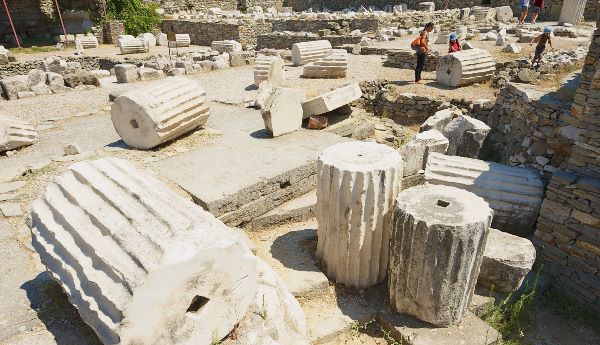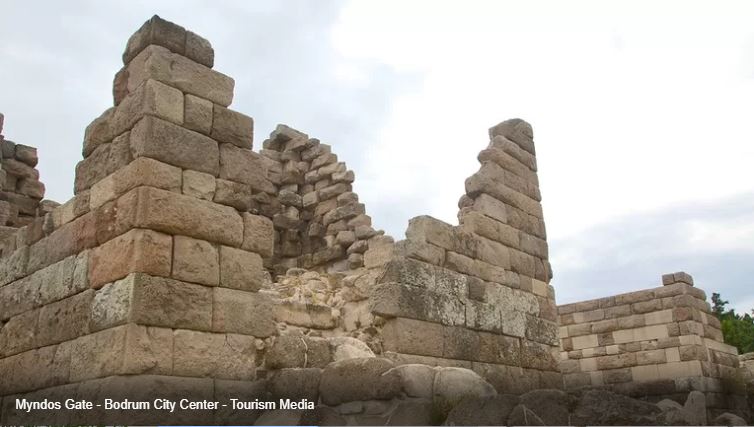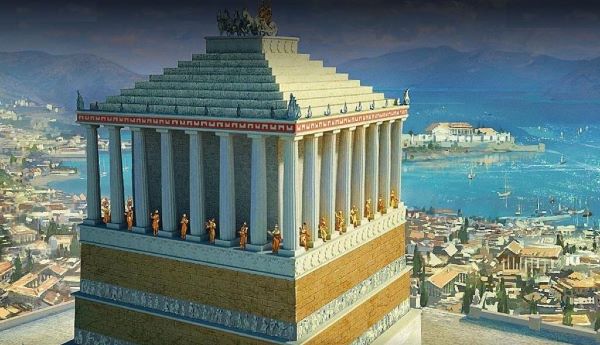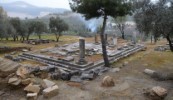he Mausoleum at Halicarnassus or Tomb of Mausolus[a] (Ancient Greek: Μαυσωλεῖον τῆς Ἁλικαρνασσοῦ; Turkish: Halikarnas Mozolesi) was a tomb built between 353 and 350 BC at Halicarnassus (present Bodrum, Turkey) for Mausolus, a satrap in the Persian Empire, and his sister-wife Artemisia II of Caria. The structure was designed by the Greek architects Satyros and Pythius of Priene.
The Mausoleum was approximately 45 m (148 ft) in height, and the four sides were adorned with sculptural reliefs, each created by one of four Greek sculptors—Leochares, Bryaxis, Scopas of Paros and Timotheus. The finished structure of the mausoleum was considered to be such an aesthetic triumph that Antipater of Sidon identified it as one of his Seven Wonders of the Ancient World. It was destroyed by successive earthquakes from the 12th to the 15th century, the last surviving of the six destroyed wonders. The word mausoleum has now come to be used generically for an above-ground tomb.
In the 4th century BC, Halicarnassus was the capital of a small regional kingdom within the Achaemenid Empire on the western coast of Asia Minor. In 377 BC, the nominal ruler of the region, Hecatomnus of Milas, died and left the control of the kingdom to his son, Mausolus. Hecatomnus, a local satrap under the Persians, took control of several of the neighboring cities and districts. After Artemisia and Mausolus, he had several other daughters and sons: Ada (adoptive mother of Alexander the Great), Idrieus and Pixodarus. Mausolus extended its territory as far as the southwest coast of Anatolia. Artemisia and Mausolus ruled from Halicarnassus over the surrounding territory for 24 years. Mausolus, although descended from local people, spoke Greek and admired the Greek way of life and government. He founded many cities of Greek design along the coast and encouraged Greek democratic traditions.[citation needed]
Mausolus decided to build a new capital, one as safe from capture as it was magnificent to be seen. He chose the city of Halicarnassus. Artemisia and Mausolus spent huge amounts of tax money to embellish the city. They commissioned statues, temples and buildings of gleaming marble. In 353 BC, Mausolus died, leaving Artemisia to rule alone. As the Persian satrap, and as the Hecatomnid dynast, Mausolus had planned for himself an elaborate tomb. When he died the project was continued by his siblings. The tomb became so famous that Mausolus's name is now the eponym for all stately tombs, in the word mausoleum.
Artemisia lived for only two years after the death of her husband. The urns with their ashes were placed in the yet unfinished tomb. As a form of sacrifice ritual the bodies of a large number of dead animals were placed on the stairs leading to the tomb, and then the stairs were filled with stones and rubble, sealing the access. According to the historian Pliny the Elder, the craftsmen decided to stay and finish the work after the death of their patron "considering that it was at once a memorial of his own fame and of the sculptor's art.
Modern historians have pointed out that two years would not be enough time to decorate and build such an extravagant building. Therefore, it is believed that construction was begun by Mausolus before his death or continued by the next leaders. The Mausoleum of Halicarnassus resembled a temple and the only way to tell the difference was its slightly higher outer walls. The Mausoleum was in the Greek-dominated area of Halicarnassus, which in 353 was controlled by the Achaemenid Empire. According to the Roman architect Vitruvius, it was built by Satyros and Pytheus who wrote a treatise about it; this treatise is now lost. Pausanias adds that the Romans considered the Mausoleum one of the great wonders of the world and it was for that reason that they called all their magnificent tombs mausolea, after it.
It is unknown exactly when and how the Mausoleum came to ruin: Eustathius, writing in the 12th century on his commentary of the Iliad says "it was and is a wonder". Because of this, Fergusson concluded that the building was ruined, probably by an earthquake, between this period and 1402, when the Knights of St. John of Jerusalem arrived and recorded that it was in ruins. However, Luttrell notes that at that time the local Greek and Turks had no name for – or legends to account for – the colossal ruins, suggesting a destruction at a much earlier period.
Many of the stones from the ruins were used by the knights to fortify their castle at Bodrum; they also recovered bas-reliefs with which they decorated the new building. Much of the marble was burned into lime. In 1846 Lord Stratford de Redcliffe obtained permission to remove these reliefs from the Bodrum.
At the original site, all that remained by the 19th century were the foundations and some broken sculptures. This site was originally indicated by Professor Donaldson and was discovered definitively by Charles Newton, after which an expedition was sent by the British government. The expedition lasted three years and ended in the sending of the remaining marbles. At some point before or after this, grave robbers broke into and destroyed the underground burial chamber, but in 1972 there was still enough of it remaining to determine a layout of the chambers when they were excavated.
This monument was ranked the seventh wonder of the world by the ancients, not because of its size or strength but because of the beauty of its design and how it was decorated with sculpture or ornaments. The mausoleum was Halicarnassus' principal architectural monument, standing in a dominant position on rising ground above the harbor.










